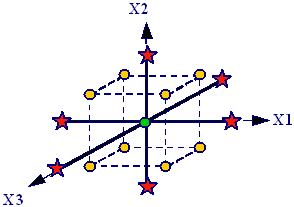Central Composite Design Technique | ||
| ||
In the Central Composite design technique a 2-level full-factorial experiment is augmented with a center point and two additional points for each factor (called “star points”). Therefore, five levels are defined for each factor, and to study factors using Central Composite Design requires design point evaluations. Although Central Composite Design requires a significant number of design point evaluations, it is a popular technique for compiling data for response surface modeling because of the expanse of design space covered and the higher-order information obtained.
The following figure shows the Central Composite Design points for three factors.

The center and star points are added to acquire knowledge from regions of the design space inside and outside the 2-level full-factorial points, allowing for an estimation of higher-order effects (curvature). The star points () are determined by defining a parameter that relates these points to the full-factorial points by:
where
baseline design
lower factorial point
upper factorial point
for
, star points are inside the full-factorial design
, star points are outside the full-factorial design
, star points are the same value as the full-factorial levels (also referred to as face-centered central composite design).